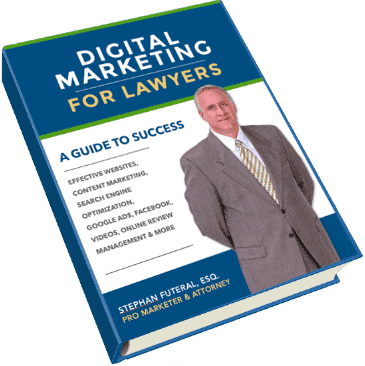Staying up to date with the latest SEO trends and algorithm updates is essential for maintaining a competitive edge on lawyer websites. As search engines continually refine their algorithms and user preferences change, law firms must adapt their SEO strategies to ensure their websites remain visible and accessible to potential clients. In this comprehensive guide, we’ll look into the most recent updates and trends in lawyer SEO, providing valuable insights for legal professionals aiming to optimize their online presence.

Staying Ahead of the Curve
Core Web Vitals and Page Experience
Google’s unyielding commitment to delivering an exceptional user experience has ushered in the era of Core Web Vitals. These vitals comprise a set of user-centric metrics that evaluate a website’s overall performance and user experience. As Google emphasizes page experience as a ranking factor, law firms must recognize the pivotal role that Core Web Vitals play in their SEO endeavors.
Website Speed Matters
Core Web Vitals include metrics such as Largest Contentful Paint (LCP), which measures the loading performance of a page. It is crucial to have a fast-loading speed to prevent potential clients from becoming frustrated and leaving your website. As a lawyer, optimizing images, streamlining code, and using browser caching to speed up loading times is recommended.
Mobile-Friendly Mandate
Mobile searches are dominant, which makes it essential to have a mobile-friendly website. The First Input Delay (FID) of Core Web Vitals evaluates interactivity, which is particularly important for mobile devices. A responsive layout, user-friendly navigation, and touch-enabled components help provide a smooth mobile experience that appeals to users and search engines.
Vital Stability and UX
Cumulative Layout Shift (CLS) gauges visual stability by measuring unexpected layout shifts during page loading. Ensuring elements don’t shift abruptly prevents user frustration and improves the overall user experience.
E-A-T and Expertise
“E-A-T” stands for Expertise, Authoritativeness, and Trustworthiness – three crucial qualities for creating reliable and relevant content. It’s not just a technical term but an important factor that Google considers to ensure users are presented with trustworthy information. Understanding and implementing E-A-T principles is crucial for law firms looking to make an impact online.
Showcasing Legal Expertise
To be recognized by Google’s algorithms, law firms must showcase their legal expertise through well-crafted content demonstrating a deep understanding of legal nuances and complexities. Providing clear and insightful explanations of legal concepts highlights the firm’s expertise to clients and boosts its visibility on search engines.
Credential Display
When showcasing lawyers’ credentials, it’s important to be transparent and highlight their qualifications and achievements. Attorney profiles should include their educational background, years of experience, bar associations, and any specialized certifications. This helps to establish the firm’s authority in its practice areas and adds credibility to the lawyers’ expertise.
Fostering Trust
Establishing trust is essential for E-A-T. It can be achieved by providing accurate, up-to-date, and verifiable information. Offering reliable legal counsel, providing citations for legal sources, and maintaining consistency across platforms all contribute to building the credibility that search engines prioritize.
Consistency Across Platforms
Google assesses a company’s reputation beyond its website. Maintaining a cohesive brand image across multiple online platforms, such as social media and legal directories, can enhance its authority and establish the company as a reliable legal source.
Featured Snippets and Position Zero
Getting into the highly sought-after “Position Zero,” the featured snippet, has become a crucial game-changer. With the rise of voice search and the need for quick answers, featured snippets have become increasingly prominent. Mastering this SEO element is essential for law firms looking to improve their visibility, and brand recognition is pivotal.
Capturing the Quick Answer
At the top of search results are brief responses called featured snippets that give users a fast answer to their inquiry without having to visit a website. This allows law firms to offer legal knowledge and establish their credibility directly in search results.
Voice Search Compatibility
As voice-activated devices become more common, featured snippets have become an ideal tool for voice search. When a user asks a question using their voice, search engines frequently utilize featured snippets to provide a quick answer. This makes them a valuable resource for connecting with users looking for concise responses.
Visibility and Credibility
When your law firm appears in the featured snippet position, it gains greater visibility and establishes itself as an authoritative source of information. This prime real estate inspires trust in users, who are more likely to recognize and value your brand’s credibility.
Strategic Content Structuring
Craft content with snippet-friendly formatting to increase your chances of being featured. This includes concise answers, bullet points, tables, and Q&A formats. Identify common legal questions and create content that succinctly addresses them. You can improve your visibility by aligning with the format search engines prefer for snippets.
Answering User Intent
Focusing on the user’s intent is important to secure featured snippets. This means understanding the specific details of the user’s query and providing a comprehensive and concise answer. By doing so, your company’s content will be recognized as a valuable resource for search engines.
BERT Algorithm and Natural Language Processing
Being aware of Google’s algorithmic updates is crucial for success. One update, the BERT algorithm, is a game-changer representing a significant shift in how search engines interpret user queries. BERT, which stands for Bidirectional Encoder Representations from Transformers, focuses on natural language processing, which law firms can use to their advantage.
Understanding User Intent
Google’s BERT algorithm goes beyond just keywords and focuses on understanding the subtle details of user queries. Google strives to provide more precise search results by comprehending the context and intent behind questions. For legal firms, this means tailoring content to match how users inquire about legal matters.
Direct and Concise Responses
The BERT algorithm rewards content that provides direct and concise answers to users’ queries. Instead of relying solely on keyword stuffing, law firms should focus on crafting content that succinctly addresses common legal inquiries in a conversational and easy-to-understand manner.
Long-Tail Keywords and Context
BERT’s emphasis on context means that long-tail keywords and specific phrases are more crucial than ever. Law firms should identify the phrasings and questions users typically ask and create content that mirrors those natural language patterns.
Human-Centric Content
BERT’s goal is to make search results more human-like. Law firms can achieve this by creating content that speaks to users in a way that mirrors real conversations, using language that’s clear, approachable, and aligned with common legal queries.
Conquering the BERT Landscape
Adapting to BERT means understanding that content is king—so long as it’s user-centric. Crafting content that genuinely answers users’ questions and adopts natural language patterns aligns with Google’s algorithmic shift and resonates with potential clients seeking clear, straightforward legal information. For law firms, embracing BERT isn’t just about navigating algorithms—it’s about forging meaningful connections through content.

Video SEO for Lawyers
Using videos offers a dynamic and engaging avenue to showcase legal expertise while forging connections with potential clients. By harnessing the potential of video content, law firms can captivate audiences, answer pressing legal questions, and solidify their position as trusted legal advisors.
Visual Engagement
Videos possess a unique ability to capture attention and convey information in a visually appealing and engaging manner. For lawyers, this means the opportunity to distill complex legal concepts into digestible visuals that resonate with audiences seeking clarity.
Addressing Legal FAQS
Legal FAQs are a treasure trove of content ripe for video adaptation. By creating videos that directly address common legal questions, law firms can establish themselves as reliable sources of accurate information and provide valuable insights to potential clients.
Building Connections
Videos offer a personal touch that text alone may struggle to convey. By putting faces to names and showcasing the personalities behind the legal counsel, law firms can humanize their brand and build a sense of connection with viewers.
Optimizing Video SEO
Like text-based content, optimizing video SEO is essential. Creating descriptive titles, detailed video descriptions, relevant tags, and engaging thumbnails enhances discoverability and encourages higher click-through rates.
Positioning as a Knowledgeable Authority
Video content allows lawyers to showcase their expertise through insightful commentary, explanations of legal processes, and practical tips. Videos position lawyers as knowledgeable authorities when discussing recent legal developments or dissecting intricate legal matters.
Mobile-First Indexing
As mobile searches continue to surpass desktop searches, the shift toward mobile-first indexing highlights the growing importance of mobile devices in online interactions. Law firms must prioritize creating a seamless mobile user experience to succeed in the digital arena.
Mobile Dominance
Mobile-first indexing means that Google predominantly uses the mobile version of a website’s content to rank and index pages. As mobile usage becomes ubiquitous, law firms must prioritize creating websites that are not only responsive but excel in the mobile environment.
Responsive Design
A responsive design ensures that a website seamlessly adapts to different screen sizes, delivering optimal viewing and navigation experiences across devices. A responsive website enhances user experience and aligns with Google’s indexing preferences.
User-Centric Design
Mobile users have distinct behaviors and preferences. Prioritizing user-centric design elements such as easily clickable buttons, streamlined navigation, and concise content formatting ensures mobile visitors can access information effortlessly.
Page Speed Matters
Mobile users demand speed. A mobile-friendly website that loads quickly and provides immediate access to information caters to users who are often on the go and seeking instant answers.
SEO Implications
Having a robust mobile presence is not only about meeting user expectations but also affects SEO rankings. Google’s algorithms consider mobile-friendliness as a ranking criterion, indicating that websites optimized for mobile are more prone to rank higher in search outcomes.
User Intent Optimization
The approach to search engine optimization has changed from focusing only on keywords to understanding the user’s intent. Law firms must now understand the reasons and inquiries behind users’ searches to create content that drives traffic and satisfies their needs.
Deciphering Intent
User intent revolves around the “why” behind a search. By discerning whether users are seeking information, looking for a solution, or aiming to make a decision, law firms can tailor their content to address those intentions directly.
Quality Over Quantity
User intent optimization prioritizes content quality over keyword density. Instead of overloading content with keywords, law firms can focus on delivering comprehensive, insightful, and value-driven content that genuinely satisfies users’ queries.
Answering the “What” and “How”
User intent optimization goes beyond answering “what” a user is searching for; it extends to addressing “how” to meet their needs. This involves providing actionable advice, practical steps, and relevant insights that resonate with users seeking actionable guidance.
Long-Tail and Conversational Phrases
Understanding user intent often leads to optimizing for long-tail keywords and conversational phrases that align with natural language patterns. This approach helps law firms capture the essence of what users seek and create content that mirrors their real-life queries.
Relationship Building
When law firms align their content with the user’s intent, they can establish meaningful relationships with their audience. By addressing their queries directly, firms can position themselves as a trustworthy source of information and build a foundation of trust.
Secure Website (HTTPS)
Ensuring website security isn’t only important for safeguarding sensitive information and plays a critical role in search engine rankings. Google has emphasized user safety, so secure websites with HTTPS have been given priority. For law firms, having a valid SSL certificate to secure their website is paramount.
HTTPS and SEO
Google’s algorithms view secure websites more favorably, considering them safer for users. Adopting HTTPS isn’t just a security measure; it’s an SEO strategy that can impact search engine rankings and visibility.
Trust and User Experience
A website that ensures security is essential in building trust among users. Regarding sensitive legal issues, people are more inclined to engage with law firms that offer a safe browsing environment. Secure connections improve user experience and boost the firm’s credibility.
SSL Certificate
SSL (Secure Sockets Layer) certificates encrypt data exchanged between a user’s browser and a website, ensuring secure transmission of information. Law firms should obtain and install a valid SSL certificate to convert their website URLs from “HTTP” to “HTTPS.”
Ranking Signal
HTTPS has evolved from a mere ranking signal to a necessity. Google’s Chrome browser even marks websites without HTTPS as “Not Secure,” which can deter users from interacting with the site.
Mobile Consideration
With mobile users dominating online interactions, a secure website is especially critical. Google’s mobile-first indexing further emphasizes the importance of providing a secure browsing experience for mobile users.

Turn to the Experts in Building Lawyer Websites!
As search engines refine their algorithms and user behaviors evolve, SEO strategies must evolve in tandem to ensure consistent online visibility and engagement. Staying informed about the latest updates and trends allows you to effectively refine your firm’s digital strategies to reach and connect with potential clients.
For tailored guidance and expert assistance in optimizing your legal practice’s website, contact JustLegal Marketing today. Our skilled and experienced team can help you navigate the complexities of the digital landscape to achieve optimal results.


